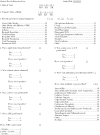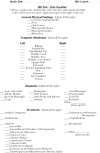An observational study of antibiotic prescribing behavior and the Hawthorne effect
- PMID: 12546288
- PMCID: PMC1464047
- DOI: 10.1111/1475-6773.10482
An observational study of antibiotic prescribing behavior and the Hawthorne effect
Abstract
Objectives: To assess whether prospective, observational study procedures, including questionnaires and audio recording, are associated with different patterns of physician diagnostic decision making and antibiotic prescribing.
Data sources/setting: (1) Survey data from a prospective observational study of treatment patterns for children with acute upper respiratory illnesses (10/96-3/97) and (2) retrospective medical record abstraction data of nonobserved encounters for the same problems occurring during (10/96-3/97) and one year after (10/97-3/98) the observational study period. Ten pediatricians in two community practices were studied.
Study design: Patterns of diagnoses recorded in the medical record and antibiotics ordered for visits occurring outside of the observational study (same time period and one year later) were compared with the pattern of diagnoses and antibiotics ordered during the observational study.
Data collection/extraction methods: For the observational study (10/96-2/97), diagnosis and treatment choices were obtained from questionnaires completed by physicians immediately following the visit. For the nonstudy encounters (10/96-3/97 and 10/97-3/98), data were abstracted from medical records one year after the observational study was completed.
Principal findings: The proportion of viral cases in which an antibiotic was prescribed was 29 percentage points lower for the observational study compared to the retrospective analysis (p < .05). In one of two study sites, the proportion of cases assigned a bacterial diagnosis was 29 percentage points lower in the observational study period compared to the retrospective study (p <.05).
Conclusions: Observational study procedures including questionnaires and audio recording can affect antibiotic prescribing behavior. Future observational studies aimed at examining the frequency of inappropriate antibiotic prescribing should measure and adjust for the Hawthorne effect; without such adjustments, the results will likely underestimate the true degree of the problem. Future interventions aimed at decreasing inappropriate antibiotic prescribing should consider "harnessing" the Hawthorne effect through performance feedback to participating physicians.
Figures
References
-
- Arborelius E, Timka T. “In What Way May Videotapes Be Used to Get Significant Information about Patient–Physician Relationship?”. Medical Teacher. 1990;12(2):197–208. - PubMed
-
- Barden LS, Dowell SF, Schwartz B, Lackey C. “Current Attitudes Regarding Use of Antimicrobial Agents: Results from Physicians' and Parents' Focus Group Discussions.”. Clinical Pediatrics. 1998;37(11):665–72. - PubMed
-
- Campbell JP, Maxey VA, Watson WA. “Hawthorne Effect: Implications for Prehospital Research.”. Annals of Emergency Medicine. 1995;26(5):590–4. - PubMed
-
- Carabin H, Gyorkos TW, Soto JC, Joseph L, Payment P, Collet J-P. “Effectiveness of a Training Program in Reducing Infections in Toddlers Attending Day Care Centers.”. Epidemiology. 1999;10(3):219–27. - PubMed
Publication types
MeSH terms
Substances
LinkOut - more resources
Full Text Sources
Medical





